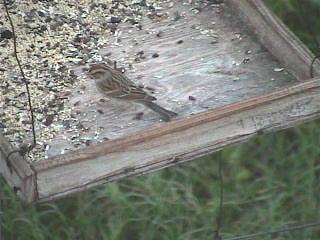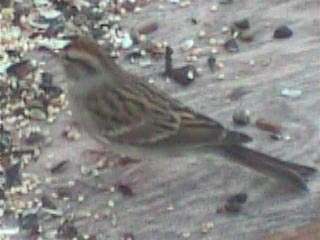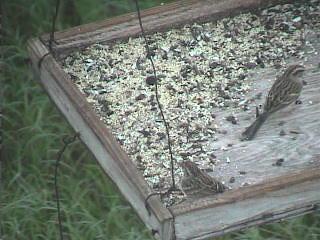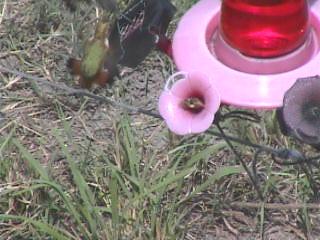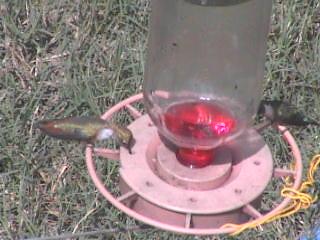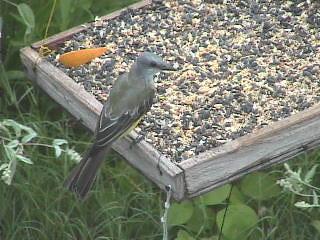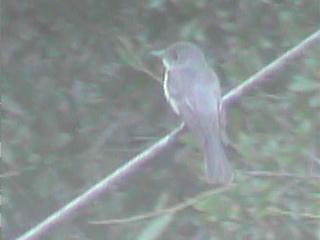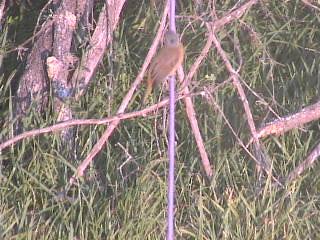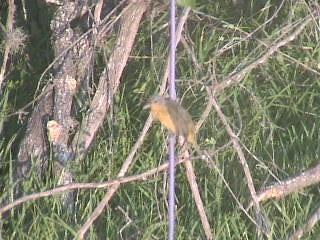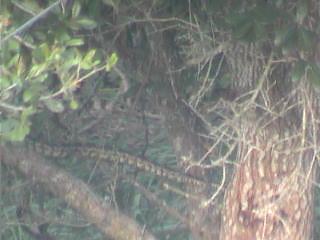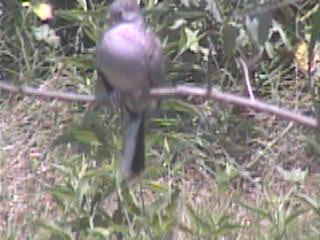My wife Linda and I took a walk to the beach and back with Toby, our yellow lab, today. It was a nice walk, with an unexpected surprise: As we were on our way back, we found a dead bird next to the sidewalk. I snapped a few photos with my phone; I’m going to put them below the fold in case people don’t want to see pictures of a dead bird.
Archive for the ‘Identification Challenges’ Category
A Discovery
Thursday, October 23rd, 2008LBJ of Mystery!
Thursday, October 23rd, 2008With txbird driving, a little brown job was photographed in the bare tree beyond and to the right of the pond at 7:27 this morning (oops; yesterday morning, now). I’m pretty sure it’s a new species for the game, though it’s not immediately obvious what species it is. Photos were taken by annelizabeth, loughman1, rafa, txbird, and vanilla, though it looks like vanilla must have subsequently deleted hers. But rafa was clever enough to save all 14 of the original images, and nice enough to forward them to me, so I can display them all in this posting.
There were a number of duplicates (that is, images that were snapped at the same moment by two different players). When I consolidated those, I ended up with 10 images total. I stitched them together into a couple of GIF animations, which allowed me to get a better sense of the bird’s movements (and coincidentally, to shift the frames to compensate for the camera’s pan during the sequence of shots, so the bird stays relatively stationary in the animation).
Here’s my first try at an animation. In this one, each frame takes 1 second:
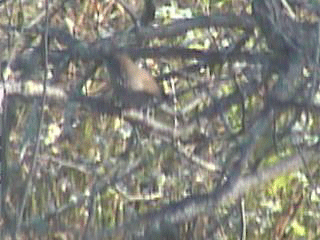
Here’s a second animation. In this one, I made the pauses between the frames match the (longer) pauses between the actual times when the original shots were taken. In other words, the timing of this animation matches the realtime movements of the bird:
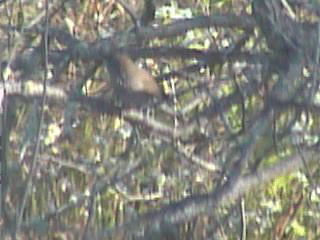
In each case, the shot where the bird is facing mostly toward the camera is the first frame. The shot where the bird has hunched down and looks like it’s about to exit, stage left, is the last frame (though I just made the animation loop continuously). Note also that in the third frame in the sequence, the bird’s tail is partly cut off by the edge of the original image (the camera had been panned to the left). It doesn’t look like that in the animation, because I “cheated” by including the background from one of the other frames, but if you look closely you can see it. I only mention it because I don’t want people scratching their heads over the odd-looking shape of the tail in that one frame.
So, after all that, what do we have here? Speculation in chat covered quite a range, from female Indigo Bunting to Dark-eyed Junco to Ovenbird to Hermit Thrush. Speaking for myself, the first thing I thought was “wren”, and as I scanned through the images I kept hoping to see a light eye stripe that would say “Bewick’s” or “Carolina”. There wasn’t any such eye stripe, as it turned out, but in terms of the overall coloring, posture, and general proportions I really like House Wren. I noticed that birderbf thought the same thing, based on a comment on this image. There are a few shots where I feel like I can see a wren-like beak. At the same time, there’s no apparent barring on the tail, which I’d like to see for a House Wren, though maybe it’s just not visible because of the quality of the image.
loughman1 was leaning toward Hermit Thrush in the chat, and I have to admit that this bird’s coloration and posture both seem pretty good for Hermit Thrush. In looking at the realtime version of the animation, the bird’s sluggishness reminds me more of a thrush than a wren. There’s also that hint of mottling on the throat in the first image — could that be a low-resolution version of a Hermit Thrush’s spots?
One thing that would settle this is size: a House Wren would be noticeably smaller than a Hermit Thrush. My subjective sense of the scale of the image (based on my vague recollection of other birds of known size in that tree) is that this bird looks more wren-sized than thrush-sized, but I’d like to see some comparison shots of known birds in the same location at a similar zoom to be sure. Does anyone know of any such shots?
I guess I’m going to sleep on it and see how I feel in the morning before committing to an ID. In any event, thanks to txbird for finding this great bird, to all the players who got photos of it, and to rafa for saving and forwarding the full set of pre-deletion images. Mystery birds are fun!
Update: ottavia suggested I check out the following YouTube video of a House Wren. She thinks it looks like the mystery bird. What do you think?
Chipping Sparrow!
Tuesday, October 21st, 2008Rufous Hummingbird?
Thursday, September 11th, 2008Yesterday and today a number of pictures were taken of one or more very interesting-looking hummingbirds. Reading through the chat, people seem to be pretty sure it’s a female Rufous Hummingbird, which I can certainly believe, though I’ve never felt confident in distinguishing female Rufous Hummingbirds from Allen’s Hummingbirds. But Allen’s would be extremely unusual (maybe completely unknown?) for Welder, whereas Rufous is listed as Rare in the fall on the Welder checklist, and I long ago gave in to the desire to ID these little gals based on geographic range if the season supports it.
I’m a little hesitant to jump completely on board with the Rufous Hummingbird classification, though, because to my eye, some of these images look to me like they might be a Broad-tailed Hummingbird, a bird that doesn’t appear at all in the Welder checklist, but that seems like a better possibility for a migration stopover than the Rufous, at least based on the Sibley range maps.
At this point a handful of images have been ID’d as Rufous, though, so hooray for the new species. I believe some of the people who are calling this a Rufous have experience banding hummingbirds, too, which is more than I can say. Anyway, here are some of the best images, courtesy of leacox, avatar99, idbirds, and annelizabeth, respectively:
Congratulations to everyone who got a shot of this cute little hummer!
Couch’s (?) Kingbird!
Friday, August 29th, 2008Shortly after the possible Eastern Phoebe photographed on the morning of 8/27, several shots were taken of what I’m pretty sure is a Kingbird. Unfortunately, I’m not sure which kingbird it is.
Here’s one of the best shots. This one was taken by idbirds:
In the chat there was some discussion about whether this was a Tropical or a Couch’s Kingbird. I can’t say I’m confident either way, but apparently enough users were confident enough for it to be successfully ID’d as Couch’s. In any event, it’s a great shot of a really attractive bird.
Things are definitely heating up on the birdcam. 🙂
Eastern Phoebe?
Friday, August 29th, 2008Some very interesting shots were taken early on 8/27. Here’s the one that I think shows the bird best, taken by txbird:
In the chat log (yay! I love the chat log!), rafa speculated about it being an Empidonax or Cantopus flycatcher (presumably an Eastern Wood Peewee in the latter case). But idbirds responded that it looked more like an Eastern Phoebe, and I think I agree. I’m not seeing the wingbars I’d expect to see otherwise.
What do you think?
Mystery Oriole 8/16
Wednesday, August 20th, 2008Livening up a dull afternoon on August 16, a yellow bird appeared briefly on a wire in view of our Welder camera. What species? Tanager or oriole?
Three people saw the bird, and two were fast enough with the camera button to give us a total of three pictures, all taken within eight seconds of each other. And then the bird was gone, and has not been seen since.
Examination of the photos allowed us to eliminate tanager and focus on oriole – but which species? For the record here, the Welder Checklist lists both Orchard and Baltimore Oriole as Uncommon in summer, Orchard as Uncommon in fall, and Hooded, Audubon’s, and Bullocks as Accidental.



The pictures were taken at a distance, and the camera resolution is not high. The pictures show the back and side of the bird, but do not show the size and shape of the beak, or the colors of the breast and belly.
And despite it being the same bird, the colors on the back seem greenish yellow in one picture (37736 – kryptonkay), but orangish yellow in another (37740 – txbird). How big is the bird, what is the relative length of the tail, is the dark color of the tail significant, can the wing bar pattern tell us anything, why is the light area over the eye visible in one picture not visible in the others, how does this bird compare with other orioles seen at Welder, how does it compare with pictures we can find in field guides or on the web? Various of us consulted Sibley, National Geographic, the new Peterson, Birds of Texas, the Audubon Society Field Guide to North American Birds, and online All About Birds, and Birds of North America. We all rued the lack of photographs showing immature birds.
Initial impressions suggested Orchard Oriole; but within a couple of hours Baltimore Oriole was added to the possibilities. Late in the evening, Bullock’s Oriole was suggested. As it became clear that none of us could provide a definitive identification, rafa posted the pictures on two listserves: “birdforum” and “texbirds,” requesting comments. Several apparently authoritative responses were received – supporting either Orchard or Baltimore. One of the more intriguing came from someone who said Orchard, and added “The plant in front looks like croton, and I’m comparing the bird’s size to the leaves.” Loughman cropped the pictures, and enhanced both the resolution and size (below) to make it easier to examine the birds. It’s easier, but not enough for confident identification.
The mystery oriole remains a mystery.

Thanks to Ken Burton and Rita Colwell for their kind help with this identification.
Lamont Brown, Katherine Miller and Keith Arnold from Texbirds list were so great to help us too with the Id. Thanks a lot!!
jbm33206 and steveo from BirdForum also contributed comments. We are most appreciative.
For anyone interested in further reading about identification of Texas Orioles, check the following links:
http://www.birdforum.net/showthread.php?p=147041#post147041
http://www.birdforum.net/showthread.php?p=148924#post148924
Mystery Bird: Summer Tanager? Clay-colored Robin?
Tuesday, August 5th, 2008A number of users got shots of the following bird this morning. Forty-five minutes of chat discussion ensued (that I missed; we really need a chat log feature). Folks seem to be leaning toward Summer Tanager (which is what I voted for, before hearing about the discussion), but at least one user is suggesting that we consider Clay-colored Robin.
Check out the images. These were taken by txbird, loughman1, txbird, vanilla, and ohiobirder, respectively.
Here’s a shot of a Clay-colored Robin that txbird found on the Web for comparison:
There’s a grayish color to this bird’s head that is really interesting to me, and that I can’t really reconcile with Sibley’s illustration of either of the birds we’re considering.
I think on balance I prefer Summer Tanager for this bird’s ID, which is a shame, since Clay-colored Robin would be a new bird for CONE. But it’s not on the Welder checklist, nor is it mentioned in the list of neotropical “species of interest” in the CONE Welder study. And really, looking at these images, it looks more like a Summer Tanager than either the web photo or the Sibley illustration of the Clay-colored Robin (a bird I’ve never seen in real life).
But either way, it’s a really interesting series of shots.
Some Noteworthy Recent Shots
Saturday, August 2nd, 2008Here are some of my favorite shots from the last few days:
birdbrain got this great shot of a snake (a diamondback rattlesnake, maybe? any herpetology experts want to chime in?) back on July 30:
After a long dry spell, several users have taken photos of Wild Turkeys lately, including this shot with two turkeys by kryptonkay on July 31:
Today (actually, yesterday now; August 1), tinyang got this shot of a bird that’s a real mystery for me. I’m really not sure what to make of it. An Inca Dove in an unusual body position, maybe? Are those white feathers on the tail?
Several photos were taken yesterday of a female Cardinal feeding a begging Bronzed Cowbird, including this great shot by rafa:
I didn’t realize that Bronzed Cowbirds were nest parasites, just like Brown-headed Cowbirds, but according to Wikipedia, all cowbirds are nest parasites. So it looks like this is a shot of a fledgling begging for food from its adoptive mother.
Baltimore Oriole!
Saturday, August 2nd, 2008It’s actually a pretty old image, but this shot by robin54 from back in early May recently picked up enough votes to get an official ID as the game’s first Baltimore Oriole:
The color definitely has a “Baltimore” feel to it. Anyway, I’ll take it. Better late than never. Congratulations, robin54!
P.S. We now have access to the nifty new linkable pages for individual images at cone.berkeley.edu, so I’m going back to my old CONE Sutro practice of making the uploaded images clickable links. Bigtime thanks to the new development team at CONE. Please keep up the good work. 🙂
